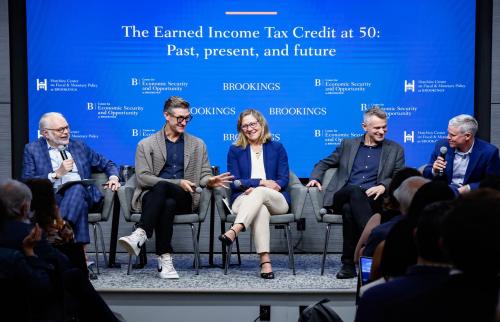We are grateful to Diana Elliott, a co-author on both the papers discussed here, for her assistance with this piece. Any errors are of course our own.
Few questions dominate politics more than the question of whether the next generation will be better off than the last; it is almost the definition of progress. That is why estimates of absolute mobility—i.e., the likelihood a child will be financially better off than their parent was at around the same age—are so important.
But these estimates can vary quite drastically. A new Urban Institute report finds that 63 percent of Americans have a higher income than their parents did. But an earlier, much-cited report from Pew painted a much rosier picture, with 84 percent surpassing their parents’ income:

A 20-point difference on such an important question is striking to say the least. The two studies use the same data set, the Panel Study of Income Dynamics, and the same variables for post-tax and transfer family income. They also use the same income deflator and the same adjustment for family size. So what’s going on? How can two reputable studies using the same data reach such different results?
Cohort effects
There are a number of possible explanations, each of which relates to subtle differences in the methodologies in the two papers:
- The early findings may overstate absolute mobility. In the Pew study, the incomes of the parents’ generation were captured when they were, on average, 41 years old, while the incomes of the children’s generation were when they were, on average, 45 years old. Some of the apparent absolute mobility, then, is likely to result from the fact that the average 45-year-old has a higher income than the average 41-year-old. But it is hard to know how large this effect is without digging deeper.
- Absolute mobility rates have fallen. Although the two papers use the same data set, the Urban Institute study analyzes a slightly younger group for the second generation: people who were aged 0-5 in 1968, compared to those who were 0-18 in 1968 in the Pew study. If younger people are doing worse, these different age cohorts will show different rates of upward absolute mobility.
- Absolute mobility occurs later in life. That the younger cohort studied by the Urban Institute appears to have lower mobility rates than the older cohort studied by Pew does not mean for sure that social mobility is declining, however. It is possible that many individuals who haven’t surpassed their parents by their 30s, may still do so later in life. (This is one advantage of the Pew methodology, since mobility is tracked later in life.)
Mind the methodology
In research as in social policy, tradeoffs are everywhere. The point is not that one approach is right and the other wrong; simply that each has pros and cons. Above all, policymakers need to be aware that technical decisions made by researchers can have quite a dramatic impact on headline results. This is true of inequality and living standards, as our colleague Gary Burtless has shown. It is clearly true of social mobility, too.
The Brookings Institution is committed to quality, independence, and impact.
We are supported by a diverse array of funders. In line with our values and policies, each Brookings publication represents the sole views of its author(s).




Commentary
How many people are better off than their parents? Depends on how you cut the data.
August 10, 2016